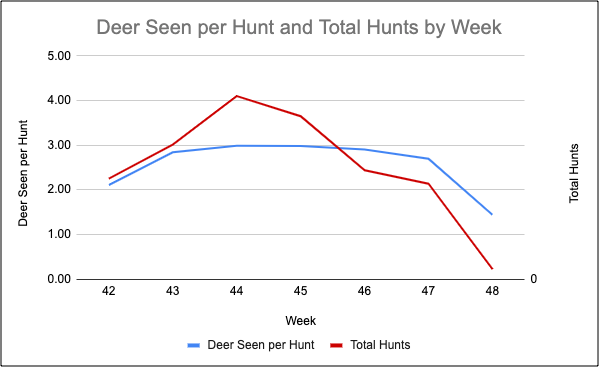When is the Rut?
It’s that magical time of the year - The Rut. It’s something we think about all year as whitetail hunters in anticipation. This post takes a look at deer activity from last year to help us better understand deer movement and how best to time the rut this year. This is just some more data and a few for you to consider when planning your upcoming rutcations.
Now as we all know, there are many other factors that influence deer movement - hunting pressure, weather as well as potentially the moon phases. We talk about this on our Rut Report page; however, this is using hard data collected in the Quiver App by hunters to help give us the best idea of when deer movement spikes around the rut.
This data is looking back at October and November in 2021 across the midwest states of Minnesota, Wisconsin, Illinois, Michigan, Ohio, Iowa, and Indiana. More to come on the east coast as well as the south - so stay tuned. All analysis here is done in aggregate and anonymized to protect privacy.
To start us off, let’s look at total hunts logged by week during the end of October and into November. The week numbers below correspond to a particular week for the year. In this case, this is how the week numbers played out in 2021
Looking at the chart below, most hunters in the midwest targeted that first week in November. Sweet sweet November. Makes sense. Historically, that’s proven to be a great week to be in the woods.
Last year in 2021 the prediction was that we’d have a prolonged rut or trickle rut if you follow the rutting moon theory given we had two full moons occurring during the timing of the rut. Last year the fall equinox was on September 22 and fell three days after the prior full moon. As a result, the second full moon wasn’t until November 19th. This is later than usual, which is why those who follow the rutting moon theory would expect a more prolonged or “trickle rut”. Looking at the data from 2021 and the chart below, we see a very similar pattern with a prolonged period of peak deer activity (the blue line which is the average deer seen per hunt).
It’s also interesting to note that hunter activity spiked in week 44, which was Nov 1 - Nov 7, but you can see that the deer activity remained at heightened levels through week 47, which was the 22nd - 28th.
Seems to be that in a year like 2021, you still had a great chance to tag a deer later into November. Maybe you don’t need to put all your eggs in one basket in early November as far as burning your hunting days away from the family and job.
Let’s dig more into the details
Further diving into the data it’s also interesting to look at the activity by day to better understand maybe what was happening during those weeks. The red spikes below are the weekends when we see most hunting activity, which makes sense. I’m out there too. But it’s really interesting to compare that to the average deer seen per hunt as well as deer taken per hunt to see when deer movement spikes.
Interestingly enough, the data tells us that mid-week is a great time to be out in the woods. Hitting the woods during the week seems to be worth it. Burn some of that PTO, and take advantage of the kids in daycare or at school. If you look at deer taken, we see mid-week that the blue line pops up above the total hunts line in late October, as well as three weeks in November. Super interesting. Is it because there’s less pressure in the woods, or the deer can sense we’re all at work wishing we were hunting? I don’t know, but seems like trying to get out mid-week could pay off.
For reference, here’s also what the moon was doing in November of 2021 as well as some historical weather data. This weather chart is for Madison, WI just as a proxy for the midwest. Looking at the deer-taken line above, you can see it trend up throughout November whereas temps were dropping. Makes sense given what we know about deer movement and cold fronts.
So What Does this Mean for 2022
This year the second full moon falls on November 9th. Smack dab during the timing of the rut or when we’d expect to see peak deer activity. So from that angle, we might expect a shorter, more intensified rut period given the moon cycle. These first two weeks in November should be amazing, and it’ll be interesting to track the activity as we get deeper into November to see if we actually see a similar pattern to last year or if deer movement does falls off earlier in November. If anything, I believe the main takeaway here is that trying to target those mid-week sits could really pay off. For all you out there who stacked up their PTO for these weeks, good luck! Keep us posted on what you’re seeing, and we’d love to hear from you on the type of activity you’re seeing out there.








